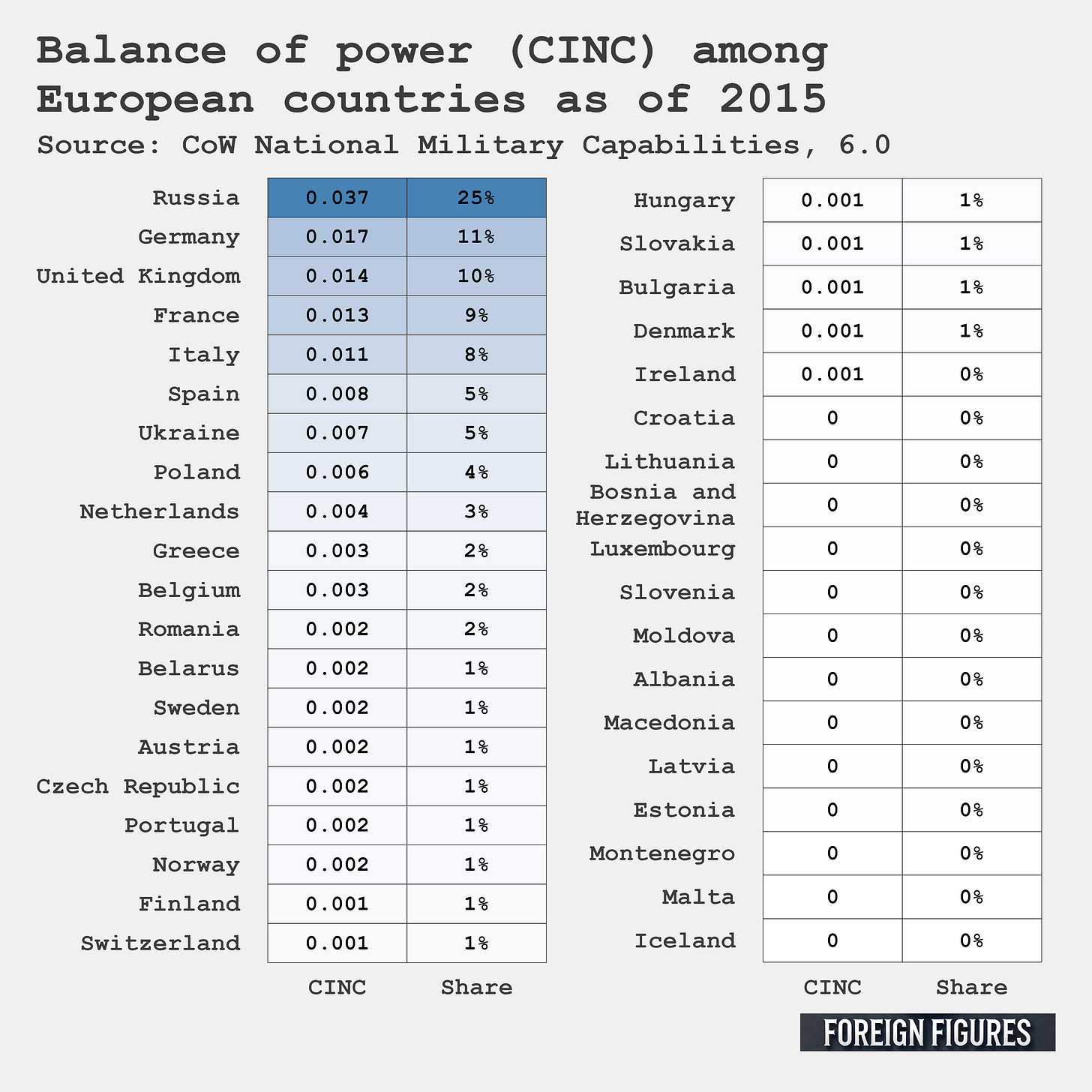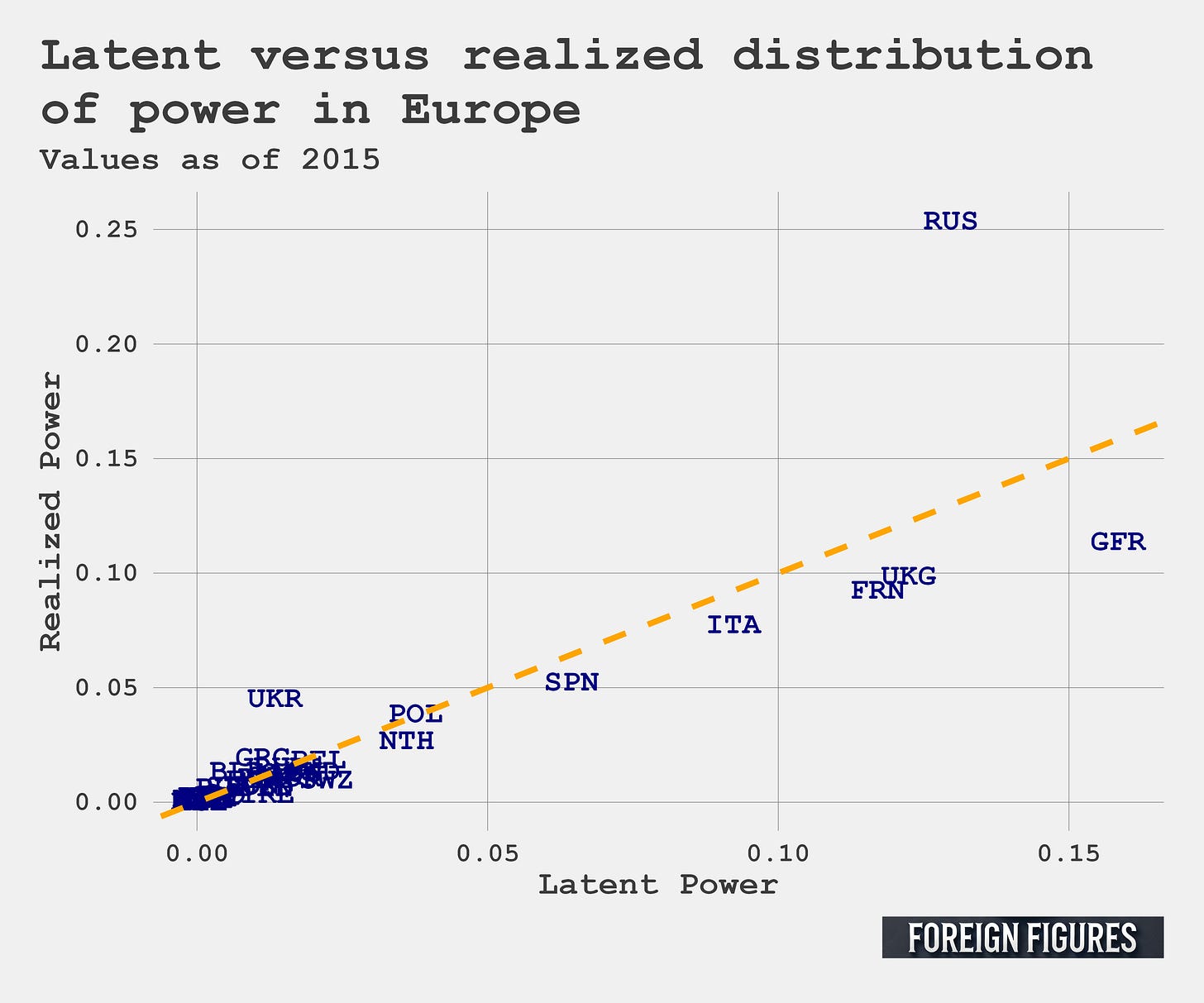A New Balance of Power in Europe
As Europe questions U.S. commitments to European security, which country will take the lead?
Thanks for reading or listening! If you enjoyed this post, show your support by liking and sharing, buying me a coffee, or subscribing!
Lord Hastings Lionel Ismay, the first Secretary General of the North Atlantic Treaty Organization (NATO), famously said that the organization was created to “keep the Soviet Union out, the Americans in, and the Germans down.” At least two of these pillars of NATO are cracking. As Russia poses a renewed threat to European security, America’s commitment to its allies wavers. Will the third pillar crack as well? Will Germany ascend?
I decided to answer this question by looking at two data sources, both of which will help me to quantify power.
Realized Power
As I’ve written before, power in international relations is a hard concept to nail down, and harder still to measure. One useful distinction to keep in mind is the difference between “realized” power and “latent” power. When IR scholars talk about the former, they usually mean hard military power, sometimes measured as military spending but more often with the Composite Index of National Capability (CINC) created by the Correlates of War Project and made publicly available in their National Military Capabilities dataset.
CINC is intended to be a comprehensive measure of a country’s share of realized power in the international system. It uses six indicators to construct a measure of power: military expenditures, military personnel, iron and steel production, primary energy consumption, total population, and urban population. It combines them into a 0-1 scale where a 1 means that a country has all the power in the system and a 0 means it has none.
As of 2015, the last year with available data for CINC, Russia is currently the most powerful country, followed by Germany, the United Kingdom, France, and Italy, in that order. I put together the below figure which summarizes the CINC scores for all European countries and then the percentage of the scores concentrated in a single country. In 2015, Russia possessed 25% of all realized power in Europe. Germany had 11%, the U.K. had 10%, France had 9%, and Italy had 8%. Most other countries barely register any realized power.
Latent Power
While Russia currently dominates Europe in terms of its realized power, the current distribution of power is unlikely to remain unchanged as U.S. commitments to the content falter. This is where latent power comes in. Latent power refers to “power resources” that a country can call upon to build up its realized military power. If realized power is like kinetic energy, latent power is like potential energy.
Gross domestic product (GDP) is one possible measure of latent power, but some IR scholars recently proposed an adjusted measure called surplus domestic product (SDP), which is GDP minus what a country has to spend to meet the subsistence needs of its population. If we use this measure, the top 5 countries remain the same as with realized power, but the order changes. You can see this in the figure below. Clocking in with $4.1 trillion SDP (measured in 2011 US dollars), Germany has the greatest share of latent power in Europe, totaling more than 16%. It’s followed by Russia, which possess 13%, then the United Kingdom and France, each with about 12%, then Italy with 9%.
The Gap between Realized and Latent Power
The discrepancy between realized and latent power is easy enough to see with one more figure — the scatter plot I’ve added below. The x-axis shows each country’s share of latent power, or SDP, in Europe, and the y-axis shows each country’s share of realized power, or CINC, in Europe. Each data point is the relevant country abbreviation, and the dashed orange line represents what a 1-to-1 relationship between realized and latent power would look like. When a country’s data point falls below this line, it means that its realized share of power is less than its latent share of power. If a data point is above the line, its realized share of power is greater than its latent share of power. There’s a clear positive correlation between latent and realized power, but among the top 5 countries in Europe, 4 of the 5 posses less realized power compared to their latent power. The only one who punches well beyond its weight is Russia. Germany, the United Kingdom, France, and Italy are lightweights by comparison.
Is a Realignment Coming?
Let’s assume that the U.S. remains an unreliable ally for Europe in the coming years. A reasonable scenario is that the distribution of power in Europe might come closer to reflecting the latent capabilities of European powers. If the distribution of SDP is a worthwhile guide, then the most likely future balance of power in Europe is plain as day. Germany will ascend to the top spot.
To be sure, it would require a lot of effort to catch up to Russia, but given the threat it posses to Europe, and the slew of spending commitments made by European powers at the most recent NATO summit, such a reordering of realized power on the content is not beyond the pale.
The great irony is that, at NATO’s inception, the idea of Germany possessing a preponderance of realized military power would have been laughable if not for the all-too-recent and grim memory of World War II. Lord Ismay is rolling over in his grave.
Code to replicate the analysis in this post can be found here.
Thanks for reading! If you enjoyed this post, show your support by liking and sharing, buying me a coffee, or subscribing!






